Part One of this article spoke of our collective yearning for peace, and the difficulty of imagining a peaceful world when we are taught to believe that “patriarchy and with it war and domination are universal and inevitable.” (Carol Christ, 2015)
But this is a myth. The peaceful civilisation of Bronze Age Crete lasted two thousand years with no sign of violence, slavery, or war. Most likely matriarchal, matrifocal, and matrilineal, ancient Crete embodied the final flowering of Old Europe. Art and archaeology reveal a life-loving people who honoured the earth, the Goddess, and nature, particularly mountains, caves, and trees. Key values and symbols of this culture of peace survive today in Cretan women’s dances and folk arts including pottery, textiles, baskets, and bread.
Here are just a few examples.
The ‘sacred centres’ of eastern Crete – Knossos, Phaistos, Malia, Kato Zakros, and Gournia – share a common architectural pattern featuring a flat and open Central Court. These ceremonial spaces are surrounded by buildings (of up to 4 stories!) and beyond that, by mountains. I suggest this architectural layout can be seen as a visual reflection of the dance circle [see Part One], in which dancers create a vertical ‘container’ surrounding a ceremonially significant open space.

The Central Court would have offered an ideal space for communal circle dance, which remains one of the most important aspects of Cretan society today.
We can also infer the presence of dance from the low round ‘omphalos’ stones still in place at Malia and Gournia. The omphalos was considered to be the navel of Mother Earth (at Delphi, too), and people danced around them in spiral and labyrinth formations, particularly in springtime. The dance space thus embodied the womb of the Divine Mother, in which dance could generate an experience of symbolic rebirth.
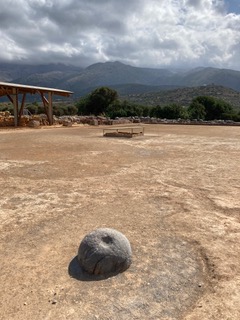
Photo: Laura Shannon
As elsewhere in the ancient world, people also danced on alonia, threshing circles. These important spaces are conveniently round and flat for dancing, and also connected to the life-death-regeneration cycle of the grain.

Grain ripens and dies, then gives new life in four distinct ways: seed for new crops; baked into bread; brewed into beer; and traded for goods. The sacred cycle of birth, death, and rebirth of the grain is the heart of the Eleusinian Mysteries of Demeter and Persephone, which Homer believed originally came from Crete.
In the Neolithic era, agriculture (along with pottery and weaving) was most likely invented by women, as Carol Christ explains. In rural Crete, women remain in charge of cultivation, storage, grinding and baking the grain, employing traditional ovens resembling the womb of the Goddess, where new life is born.

Women in rural Crete also make use of the straw which remains after threshing in the creation of astoundingly complex ritual baskets known as panéria.

These ceremonial baskets, which only a few women still make today, incorporate symbols which have been sacred since the Bronze Age. These motifs include the Horns of Consecration, the labrys or ‘double axe’, Mountain Mother, Birth Goddess, Winged Goddess, Tree of Life, priestess, and circles of dancing women.

The exact same motifs recur in the woven and embroidered aprons of women’s traditional folk costume, as well as in other ritual textiles.
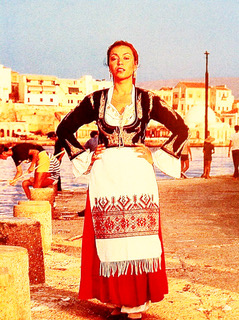
The women’s costume in numerous regions including Anoghia features a tight, low-cut, long-sleeved jacket, which supports the breasts and enables easy nursing in the childbearing years.
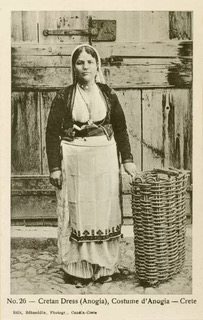
Now worn over a light tunic, this style of jacket strongly resembles the bodice of the bare-breasted Snake Goddesses of Knossos.

The upraised, outstretched stance of the Snake Goddess is reflected in the women’s traditional dance handhold.
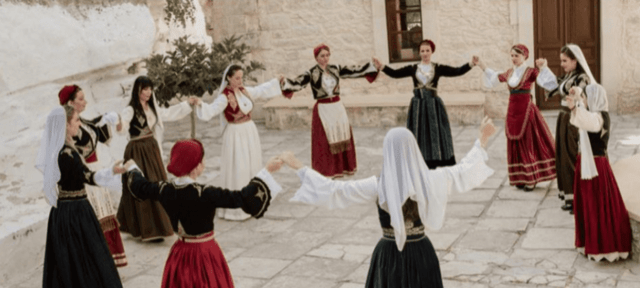
This ‘posture of power‘ comes to life in the woman’s slow-motion solo in the centre of the dance Maleviziotis / Kastrinos Pidichtos: upright and radiant, pivoting slowly on her own axis, with hands upraised and extra-long sleeves draping from her wrists like snakes.

In the ceremonial textiles woven and embroidered by women, the circle of women dancers is one of the most prevalent themes.
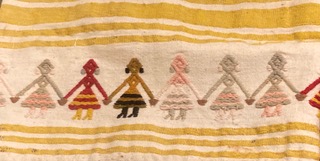
And dance remains one of the most important elements of Cretan culture today, offering ‘an embodied experience of community, equality, mutual support, shared leadership, respect for the mother and the female principle, reverence for nature and the cycles of life, and a sense of responsibility to nurture life and assure a sustainable future.’ (Laura Shannon, ‘Women’s Ritual Dances and the Nine Touchstones of Goddess Spirituality‘)
These are just a few examples of Cretan art forms which serve as containers or cradles to nurture seeds of beauty, community, and peace, from the depths of time to the present day. They can inspire us to plant and tend our own seeds of peace, in our lives and in our world. There is nothing more important than this, if we wish to build a sustainable future.
The Goddess Pilgrimage to Crete in the Footsteps of Carol Christ offers a chance to collectively explore the peaceful, egalitarian Goddess culture of Bronze Age Crete. Goddessariadne.org
On December 20, the Ariadne Institute will offer an online gathering, ‘Carol Christ and the Pilgrimage to the Goddess’, to celebrate Carol P. Christ: pioneering feminist theologian, Goddess scholar, co-founder of the women’s spirituality movement, initiator of the Goddess Pilgrimage on Crete, and beloved friend. This Zoom event is free of charge. Details will be available soon at goddessariadne.org.


Thank you. It was fascinating to learn how the ancient symbols and actions are continuing into the present day. The photos showing this are wonderful.
LikeLike
Thank you so much for these two articles, Laura. This summer I had an epiphany while reading “Sanctuaries of the Goddess” by Peg Streep. The culminating chapter on Goddess culture includes wonderful photos of the ancient temples of Crete and Santorini. I was overwhelmed and vividly carried back to my own lives in this culture. I realize now that in some of these lives I was probably a man, and I carry a vision of the beauty of a man’s life in those times, adoring the Mother and Her sacred womb. FAR published 4 of my poems from that epiphany, in a post called “Ancient Her Story.” I’m sure there will be more! I relive this highly generative and joyful culture in your beautiful examples of dancing grounds, postures and embroideries. When I see them, I can’t help but praise Her all the more.
She calls across the ages,
like a beacon, a clarion call, a prophetess,
like an ancient howling in the night.
LikeLike
Thank you, Annelinde! The ancient culture of Crete lives on in so many ways, including your own past-life memories and your beautiful poems. I missed your post when it came out this summer, and loved reading it now. I quote from you: ‘When I got to Chapter 7 of Peg Streep’s well-researched book, “The Goddess at the Peak: Crete,” I was blown away with the evidence we still have, in art, architecture, religion and culture, of a highly advanced society, full of life and joy, where women were central to all life.’ Your poetry portrays this world with such grace. I encourage everyone to read your poems at https://feminismandreligion.com/2023/08/05/ancient-her-story-by-annelinde-metzner/
LikeLike
some really nice photos here
LikeLike
I just love this Laura. You help us re-member the dance.
LikeLike
This is a beautiful article.
But is the bottom line that we as women need to demand that men stop fighting wars? I don’t think men will stop on their own.
LikeLike
Such a good question…. Annelinde’s comment above about the ‘beauty of a man’s life in those times, adoring the Mother and Her sacred womb’ highlights how, in that earlier time, men also lived in peace. And in our time, it isn’t just men fomenting war, it’s a whole culture. We’ve all seen that it can be pretty easy for women raised in a patriarchal, misogynistic culture of hierarchy and competition to behave in a ‘war-like’ way towards others – having integrated the dominant values of violence and hatred, and also usually directing inwards towards themselves. There is so much to heal.
LikeLike
This is fascinating! I am especially interested in how you show that the architecture echoes the circle dance and how important this is to creating a joyful, peaceful, vibrant society. This and the other lessons in your essay are all things we can bring to our own communities in various ways.
LikeLike
Yes! It’s so good to see how such simple things can be steps towards ‘creating a joyful, peaceful, vibrant society’, for them and also, therefore, for us. I find my hope in these simple survivals of beauty, community, respect and reverence for nature and all beings.
LikeLike
I really enjoyed these articles, Laura. The older I get the more I appreciate how ritual and movement bring peace and a sense of being centered, part of a whole. I was also reminded of a youthful time when a very budget holiday on Crete opened my eyes to Minoan culture in the land, the ruins, and the museum. Thank you.
LikeLike
This second piece also makes me think of the Korean mudang (dancer) or manshin (summoner of spirits) as the Mountain Goddess once again speaking through Her dancers and bringing healing to the community. She is ever present. Blessed be.
LikeLike
Thank you Terry, that’s a great connection to make. I’ve heard of Korean shaman women but did not know about the links between the mudang and the Mountain Goddess. How can we learn more?
LikeLike
Since some believe that the ancient divinity of the mudang was a mountain goddess, you could start by looking at Korean shamanism in general, then explore the images of Mudang Oh Su-bok. Interestingly, she holds her arms in a very familiar gesture!!
LikeLike
Wow Laura, this is fascinating! I love the connections you make between Cretan dance, clothing, culture, and worship of the Goddess.
LikeLike
I just came back from my second visit to Crete. This time I danced in a circle with other people. What a joy! I can feel the Goddess/Minoan culture on Crete. This island keeps calling me back.
LikeLike
Thank you, Laura for these informative & interesting articles. The pictures reinforce the beauty of Minoan culture and the Goddess’s. I’m going to try to draw the patterns seen on some of their textiles & then embroider some linens. Crete is so beautiful and I feel at home there. I hope to make another pilgrimage with you.
Blessed be💜
LikeLike